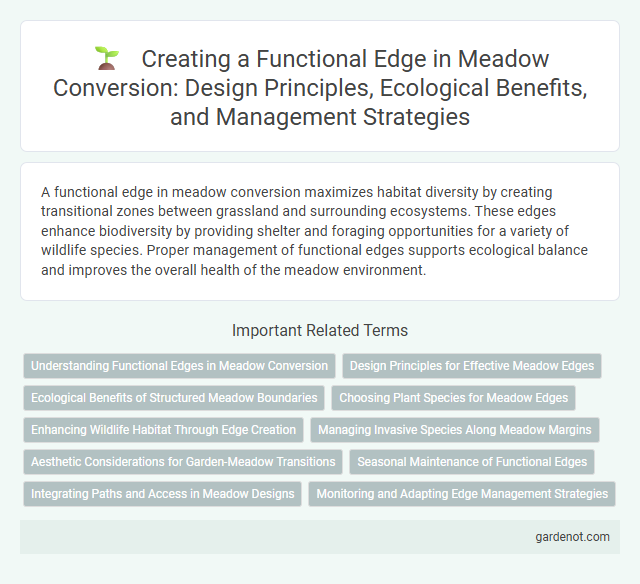A functional edge in meadow conversion maximizes habitat diversity by creating transitional zones between grassland and surrounding ecosystems. These edges enhance biodiversity by providing shelter and foraging opportunities for a variety of wildlife species. Proper management of functional edges supports ecological balance and improves the overall health of the meadow environment.
Understanding Functional Edges in Meadow Conversion
Functional edges in meadow conversion refer to the transitional zones where land management practices influence biodiversity and ecosystem services. These edges often exhibit higher species richness and act as buffers that enhance habitat connectivity between natural meadows and converted agricultural areas. Understanding the ecological functions of these edges is critical for optimizing meadow restoration and maintaining landscape-level ecological balance.
Design Principles for Effective Meadow Edges
Functional edges in meadow conversion prioritize biodiversity by incorporating diverse native plant species that create habitat connectivity and support pollinators. Design principles emphasize structural complexity with varied vegetation layers to enhance ecological functions such as soil stabilization and water filtration. Strategic placement of edges maximizes sunlight exposure and minimizes invasive species intrusion, ensuring sustainable meadow ecosystems.
Ecological Benefits of Structured Meadow Boundaries
Structured meadow boundaries with a functional edge significantly enhance biodiversity by providing diverse habitats for pollinators, birds, and small mammals. These vegetated margins improve soil health through increased microbial activity and natural nutrient cycling. Furthermore, they act as natural buffers, reducing runoff and preventing soil erosion while supporting ecological connectivity across fragmented landscapes.
Choosing Plant Species for Meadow Edges
Selecting plant species for meadow edges requires prioritizing native, drought-tolerant perennials that support local wildlife and enhance ecosystem services. Functional edge planting benefits from species like Echinacea purpurea, Rudbeckia hirta, and Solidago spp., which provide continuous bloom cycles and habitat diversity. Optimizing plant diversity at the meadow boundary increases resilience against invasive species and improves soil stabilization.
Enhancing Wildlife Habitat Through Edge Creation
Creating functional edges in meadow conversions significantly boosts wildlife habitat by increasing plant diversity and structural complexity. These transitional zones between meadow and surrounding ecosystems provide essential resources such as food, shelter, and breeding sites for pollinators, birds, and small mammals. Enhancing edge habitats supports ecological connectivity and promotes resilience against environmental changes.
Managing Invasive Species Along Meadow Margins
Managing invasive species along meadow margins involves regular monitoring and targeted removal to preserve native biodiversity and ecosystem functionality. Employing native plant buffers at functional edges enhances habitat connectivity and reduces invasive species encroachment. Integrating adaptive management techniques supports resilience against invasive threats and maintains ecological integrity in meadow environments.
Aesthetic Considerations for Garden-Meadow Transitions
Functional edge design in garden-meadow transitions enhances biodiversity by creating gradual habitat shifts that support diverse plant and insect species. Aesthetic considerations emphasize naturalistic blending techniques, such as varied plant heights, textures, and colors, to achieve seamless visual integration. Incorporating native wildflowers and grasses not only strengthens ecological function but also enriches seasonal interest and visual appeal.
Seasonal Maintenance of Functional Edges
Seasonal maintenance of functional edges in meadow conversion ensures optimal plant health and ecosystem balance by preventing overgrowth and promoting biodiversity. Regular trimming and clearing during key growth periods improve sunlight penetration and soil aeration, supporting native species regeneration. Effective edge management reduces invasive species spread and maintains habitat connectivity throughout changing seasons.
Integrating Paths and Access in Meadow Designs
Functional edge design in meadow conversion emphasizes integrating paths and access points that support ecological connectivity and human use without disrupting wildlife habitats. Carefully planned trails and entryways facilitate movement for pollinators and small mammals while encouraging responsible public interaction. Strategic placement of these paths enhances biodiversity by minimizing habitat fragmentation and promoting nutrient flow across the meadow ecosystem.
Monitoring and Adapting Edge Management Strategies
Functional edge in meadow conversion emphasizes continuous monitoring of environmental conditions and adaptive management strategies to optimize biomass productivity. Real-time data collection on soil moisture, nutrient levels, and plant health supports dynamic adjustments in grazing intensity and irrigation scheduling. This approach enhances ecosystem resilience, ensuring sustainable meadow restoration and efficient resource utilization.
Functional edge Infographic

 gardenot.com
gardenot.com